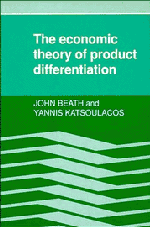Book contents
- Frontmatter
- Contents
- Preface
- 1 Introduction
- 2 Spatial models of imperfect competition
- 3 Symmetric preferences, the Chamberlinian paradigm
- 4 Product diversity and product selection: market equilibria and social optima
- 5 Product quality and market structure
- 6 Vertical product differentiation
- 7 Product differentiation and market imperfection: limit theorems
- 8 Product differentiation and the entry process
- 9 The gains from trade under product differentiation
- Notes
- Bibliography
- Indexes
1 - Introduction
Published online by Cambridge University Press: 03 May 2010
- Frontmatter
- Contents
- Preface
- 1 Introduction
- 2 Spatial models of imperfect competition
- 3 Symmetric preferences, the Chamberlinian paradigm
- 4 Product diversity and product selection: market equilibria and social optima
- 5 Product quality and market structure
- 6 Vertical product differentiation
- 7 Product differentiation and market imperfection: limit theorems
- 8 Product differentiation and the entry process
- 9 The gains from trade under product differentiation
- Notes
- Bibliography
- Indexes
Summary
The aims of the book
We had two main aims in writing this book. The first was to explain the prevalence of differentiated goods in a modern market economy and the second was to explore the implications of this for industrial structure and market power. The literature on, and our understanding as economists of, the phenomenon of product differentiation have developed greatly in the last decade and it seemed appropriate at this point to bring this all together and see what general strands could be extracted.
A central question in the theory of imperfect competition concerns the number and kinds of differentiated goods that the market mechanism will produce. One can look at this from both a positive and normative point of view. Our objective is to provide the reader with both points of view in the course of discussing the, by now, fairly substantial literature on product differentiation. Of course, we must also recognise that product differentiation is not the only source of imperfect competition. In its absence, imperfect competition may still arise. This may be for either or both of two reasons: because firms are non-negligible in relation to the size of the market or because consumers or firms possess incomplete information. While we address both of these issues to some extent in this book, they are not the primary focus. For those who want a review of the former, we would refer them to Hart (1985c), while issues of information are dealt with by Butters (1977), Grossman and Shapiro (1984), Rothschild (1973), and Salop and Stiglitz (1977).
- Type
- Chapter
- Information
- The Economic Theory of Product Differentiation , pp. 1 - 10Publisher: Cambridge University PressPrint publication year: 1991



